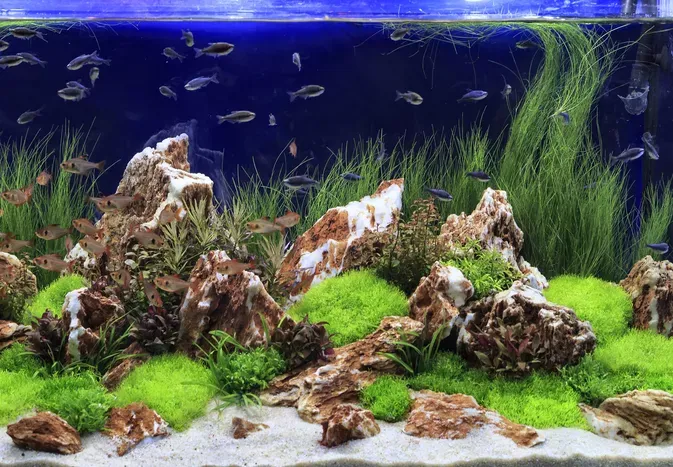What Is Aquascaping?
Updated on 04/26/24

Aquascaping: The Art of Underwater Gardens
Embark on a captivating journey into the mesmerizing world of aquascaping, a transformative art form that seamlessly blends horticulture and aquatic life. Aquascaping transcends the mundane confines of fishkeeping, elevating it to a realm of artistry and tranquility.
What is Aquascaping?
Aquascaping is the meticulous design and maintenance of underwater landscapes within an aquarium. It encompasses the careful selection, arrangement, and cultivation of aquatic plants, hardscape elements (such as rocks and driftwood), and aquatic creatures. The ultimate goal is to create a visually stunning and ecologically balanced miniature ecosystem.
Elements of Aquascaping
1. Hardscape:
The foundation of an aquascape lies in its hardscape, which includes rocks, driftwood, and other inert materials. These elements provide structure, depth, and a sense of naturalism to the underwater environment. Rocks can be used to create towering cliffs, undulating hills, or mysterious caves, while driftwood adds a touch of age and character.
2. Aquatic Plants:
The lifeblood of an aquascape is its vibrant plant life. From lush foreground carpets to towering background plants, each species plays a vital role in the ecosystem. Plants not only provide oxygen and shelter for aquatic inhabitants but also contribute to the overall aesthetic appeal.
3. Aquatic Creatures:
The addition of aquatic creatures, such as fish, invertebrates, and even amphibians, brings an element of liveliness and interaction to the aquascape. These creatures add a dynamic element to the ecosystem, as they swim, feed, and interact with their surroundings.
4. Lighting:
Proper lighting is crucial for the health and growth of aquatic plants. It provides the necessary energy for photosynthesis and enhances the visual appeal of the aquascape. Aquascapers carefully consider the intensity, duration, and color spectrum of light to create the optimal conditions for their underwater gardens.
5. CO₂ Injection:
Carbon dioxide (CO₂) is an essential nutrient for aquatic plants. Supplying additional CO₂ through injection can boost plant growth and vitality. However, careful monitoring is required to prevent excessive CO₂ levels that can harm aquatic creatures.
Styles of Aquascaping
1. Nature Aquarium:
Inspired by the natural landscapes of Japan, this style emphasizes the harmonious integration of plants and hardscape. It aims to recreate a serene and tranquil underwater environment that evokes the beauty of nature.
2. Dutch Style:
This traditional style prioritizes lush plant growth and symmetry. Dutch aquascapes are characterized by dense carpets of foreground plants, towering background plants, and an abundance of healthy vegetation.
3. Iwagumi Style:
Originating in Japan, Iwagumi aquascapes focus on the simplicity and elegance of rock arrangements. The hardscape is carefully composed to create a balanced and visually striking composition.
Benefits of Aquascaping
1. Relaxation and Stress Relief:
Studies have shown that observing an aquascape can have a calming effect on the mind and body. The soothing colors, gentle movements, and tranquil atmosphere create a serene environment that promotes relaxation and reduces stress.
2. Aquatic Ecosystem:
Aquascaping fosters a thriving ecosystem within a confined space. Plants provide oxygen and shelter for aquatic creatures, while the filtration system helps to maintain water quality. This balance creates a healthy and sustainable environment for all inhabitants.
3. Artistic Expression:
Aquascaping allows aquarists to express their creativity and artistic vision. It is an opportunity to design and craft a unique and captivating underwater landscape that reflects their personal style and preferences.
Conclusion
Aquascaping is a captivating art form that seamlessly blends horticulture, ecology, and aesthetics. It transcends the boundaries of fishkeeping, transforming ordinary aquariums into miniature underwater gardens that evoke tranquility, inspire creativity, and foster a deeper connection with nature. Whether you are an experienced aquarist or a novice eager to embark on a fascinating journey, the world of aquascaping awaits with open arms, ready to ignite your passion for the hidden wonders of the aquatic realm.
Explore More Pets

Freshwater Aquarium Filters
How to Deal With Cloudy Aquarium Water

Saltwater Aquarium Filters
How Do You Remove Chloramines From Tap Water?

Freshwater Aquariums & Habitat
Can I Keep My Koi Fish Inside?

Saltwater Aquariums & Habitat
14 Best Floating Plants for Your Aquarium

Freshwater Fish Health
How to Treat Ich on Freshwater Fish

Saltwater Fish Health
Fin Rot in Aquarium Fish

Freshwater Aquarium Filters
How to Do Aquarium Water Changes

Saltwater Fish Health
How Do Fish Get Parasites?